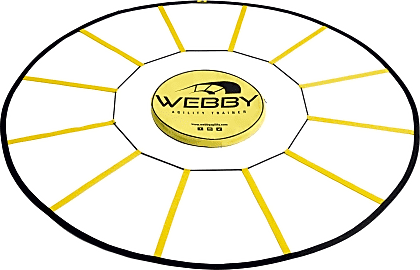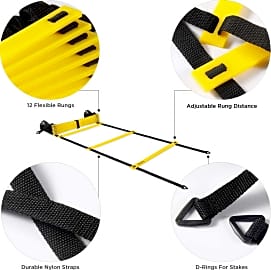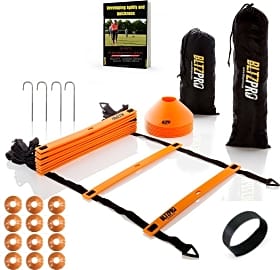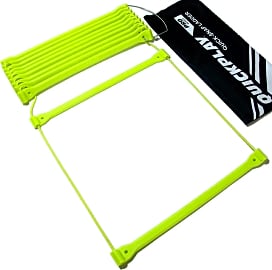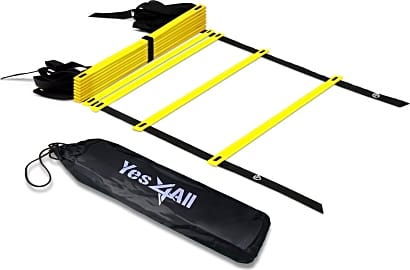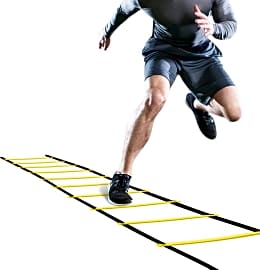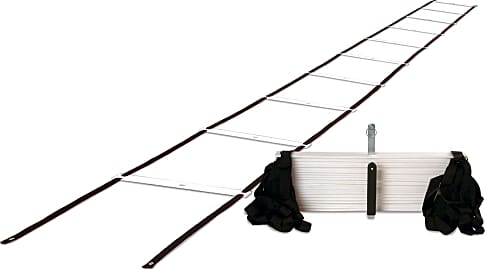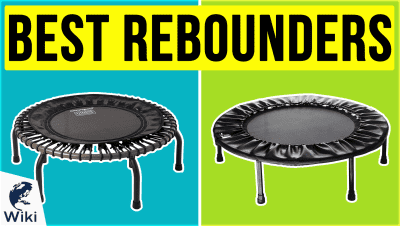The 9 Best Agility Ladders

This wiki has been updated 38 times since it was first published in June of 2015. Ideal for athletes who participate in a wide variety of sports and competitions, these agility ladders help to improve your reaction times, lateral movement, direction changes, balance and overall speed. They're lightweight and portable, so you can take one to train with at the park, and some even include accessories, like pylons and hurdles, so you can set up a little circuit . When users buy our independently chosen editorial choices, we may earn commissions to help fund the Wiki.
Editor's Notes
July 23, 2021:
Nothing new to report in the world of agility ladders, although we did have to remove a model from Golme that's no longer in production and was basically identical to the QuickPlay Multi-Sport anyhow. We still really like the Webby Circle Speed because of its unconventional design as well as the CanPPNY Training Kit because of the included resistance parachute. The Pro Footwork Training Set remains the top pick thanks to its cones and hurdles.
May 11, 2020:
During this round of updates, the World Sport Flat, Pro Footwork Set and Perfect Soccer Premium were all removed due to availability issues. Our new inclusions this time around are the Pro Footwork Training Set – which comes with four pylons and hurdles to set up an agility circuit with, the Webby Circle Speed –a twist on traditional agility ladders that features a round design, and the Canopy Training Kit – which comes with a 54-inch running parachute that can create up to 35 pounds of drag as you’re sprinting.
A few things to think about for this category:
Length: While the weight difference between six-foot ladder and a 20-foot ladder is negligible in all practical terms (for an elite athlete like yourself, anyway), the difference in utility is massive, and running drills on a short ladder can be quite frustrating, if you’re used to a longer model. So, my advice is to select the largest model that’ll reasonably fit inside your workout area.
The Canppny Training Kit comes with a 20-foot ladder that’s great for large spaces, while the Pro Footwork Training Set features an adjustable option that can be set to either six, nine or 12 feet in length, offering users quite a lot of flexibility. Not only does the Yes4All Speed offer eight-, 12- and 20-foot options, but its ladders can also be attached, allowing for the possibility of an even-longer ladder – if multiple units are purchased.
Extras: There’s no doubt that ladders can be an excellent tool for agility training, but the best way to make sure you get a great workout, not to mention hold off boredom, is to make sure you mix it up. With that in mind, several companies have included other training tools with their ladders, allowing users the option of an alternative exercise or, better yet, a bit of an agility circuit.
While the BltzPro Sports comes with a dozen disc cones and useful e-book, the Canppny Training Kit comes with five disc cones and a running parachute. The Pro Footwork Training Set comes with a printed training guide, four pylons and four low hurdles.
Warranty: In theory, once in place, an agility ladder really shouldn’t be absorbing a lot of wear and tear via impact, as a skilled individual will always step next to the ladder, and never directly on it. However, when you’re training developing athletes (or, just tired athletes, for that matter), it’s an inevitability that this ladder will be stomped on, again, and again and again, and often with heavy cleats. With that in mind, it can’t hurt to select an option that offers you some sort of warranty, and ideally a long one.
Warranties by and large are disappointingly sparse in this category, but the Golme Training and Webby Circle Speed are two options that back their product with a one-year guarantee. The Yes4All Speed sets itself apart from the competition by supporting its product with a five-year warranty.
The Ladder Of Success
Technically, by virtue of their size, they should be harder to pin down than taller athletes–rather like the difference between catching a baseball and beach ball.
It may just be a trick of perception, but, as a tall man it's always seemed to me that shorter athletes had an easier time developing their agility. Technically, by virtue of their size, they should be harder to pin down than taller athletes–rather like the difference between catching a baseball and beach ball. Plus, they have less bone mass to manipulate.
Whatever the reason for their apparent increase in agility, the quick moves these shorter athletes presented me with on the field (we're talking soccer here, in particular) inspired me to work harder to increase my own agility.
A friend of mine is a personal trainer for young female soccer players. She is, undoubtedly, in the best shape of anyone I know, male or female, and she was kind enough to show me some exercises I could do to increase my agility without bankrupting myself from the cost of her services.
The first thing she took out of her bag was an agility ladder. I recognized it immediately from a workout program I owned years prior. I foolishly thought at the time that I could fake the ladder by simply taping off similarly sized sections on my floor. Not only did the tape ladder fail to work in the multifaceted way that the real three dimensional ladder would have, the tape itself wound up permanently damaging the floor it stuck to, losing me my security deposit.
Used for its most common application, an agility ladder's specific spacing is its primary offering. In order for it to work properly, however, you have to take on the mindset of an imaginative child. Think back to your days playing hopscotch, when your feet absolutely had to land within the perimeter of the boxes beneath you or something awful would happen. Perhaps you would fall into a gaping pit of lava. At the heart of things, agility ladders create an advanced game of hopscotch for adults.
You can lay your ladder out in any number of configurations, reducing the targeted landing space for your feet to attain a greater accuracy and precision along with your agility. You can run your ladder in straight lines, curves, or angles, depending on how you feel you need to train. Keep your knees up, engage your core, and get moving.
Where Will You Lay Your Ladder Down?
Since all the ladders on this list are each significantly less expensive than your security deposit or the cost of new flooring, it's a good idea to avoid the tape nightmare described above, and to invest in a real training ladder. Choosing from among these ladders will come down to a few basic questions about your training style and your workout space.
One of the best things about these ladders is that you can't really buy one that's too long.
If you already know a good deal about agility training, or if you've used these ladders extensively at a gym of as part of a team, and you want to get one into your home for additional workouts, then you probably don't need a ladder that comes with a lot of instructional materials. Conversely, if you're new to agility training, a few of these packages have great materials included with them, so you can get started with confidence. One of them even has additional hardware to increase the variety of your training.
Another factor is the space itself. One of the best things about these ladders is that you can't really buy one that's too long. If the space in which you exercise is too limited, you can double the ladder up on itself, or you can keep one of the two ends furled, using only the unrolled portion. If your space is open and accommodating, you can reach for the biggest ladder you can find without worry.
One of the ladders on this list is more of a mat than anything else, and that brings us also to your training surface. If you're working toward more general agility, a simple mat surface, or even hardwood, would be a fine place to lay out your ladder. Field athletes, however, would do well to lay their ladders down on grass or turf, to better replicate the environment in which their agility will be tested. That mat-like ladder won't sit well on grassy fields, however, so make sure your ladder is suited to your environment.
Training Through The Ages
Physical training has been a strong tenet of athletics since the sporting days of ancient Greece and the heights of the Mayan civilization. Sports in those days were deeply connected with military prowess, and a land known for its sportsmen would be feared for its military.
Physical training has been a strong tenet of athletics since the sporting days of ancient Greece and the heights of the Mayan civilization.
It wasn't until the 20th century that a more scientific bent toward athletic training took shape. American football led this charge more than any other sport, developing training techniques and workout routines designed to maximize muscle mass while emphasizing agility.
Trainers quickly integrated computers into their programs and research, developing better and better ways to train their athletes. Armed with much of this data in 1998, Steven and James Myrland patented the first agility training ladder. It's purpose was to take "high knee" exercises and imbue them with safe, specific targets for the feet, adding precision and nimbleness to a cardiovascular movement.
It'd be fascinating to see how today's athletes would have fared with their superior training methods in those more barbaric times. Would our mindset be so different in the face of possible death that our bodies would fail us, or would the training take over and save our skins?


